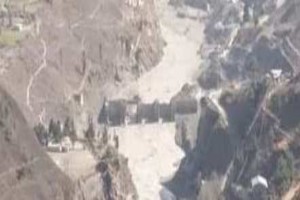
Perspective
 By Kaushal Kishore*
By Kaushal Kishore*
The problem of silt is in focus again due to destruction of the RishiGanga Barrage
The recurrence of the flash floods in the Himalayas is now becoming frequent. Rainy weather is no longer a mandatory condition for it. Last year the flooding started in the eastern Himalayas with the inception of the summer heat. A series of flood waves were continued until the end of the monsoon months. As a consequence many districts of Assam suffered.
The agitation against 56 hydro-power projects in the tribal district of Lahaul Spiti in Himachal Pradesh has intensified following the devastation in Uttarakhand. The villagers have passed resolution in the panchayat against impending no objection certificate for the project. Environment protection groups are better organised in eastern part of the Himalayas than the western region. The government refers to these lovers of the mother nature as a Chinese agent. It’s harmful for the nation. They need to learn lessons from the Prime Minister Narendra Modi and the Defence Minister Rajnath Singh.
Once again the Himalayan valley has witnessed the deluge at Uttarakhand. The disaster management services jumped into the rescue operation. So far a number of workers are safely evacuated from Tapovan tunnel. The Chief Minister of Uttarakhand Trivendra Singh Rawat has sent a couple of hundred million rupees for this purpose. The government in the Centre and State have announced the relief packages for the families of the deceased and injured victims. This softness is not limited to that. The generous people in the private sector never miss such an opportunity.
Despite all these efforts, it’s not possible to compensate the damage. To ensure wellbeing of its victim is not an easy job. The reconstruction is the next step, and its preparations will start tomorrow. Development dreams are valuable indeed.
Today, the Chamoli disaster is capable to turn the smouldering embers into the blazing fire in the tribal regions. This difficulty should be avoided.
The problem of silt is in focus again due to destruction of the Rishi Ganga Barrage. However the state successfully controlled the flood in downstream by stopping the flow of certain dams. The damages were limited in the absence of such dams in the path of flowing water. In fact the siltation starts in the upstream due to the dams. The reason behind this is the political economy that allows the flow of water in the river, but sand and silt.
The former Prime Minister Rajiv Gandhi had launched the Ganga Action Plan, and initiated the construction of Tehri Dam on the Bhagirathi. The experts estimated that its huge reservoir will be filled with silt within next hundred years. But the pace of silt deposition is faster than the expectation. Local activists known to have raised their voice against the Tehri dam claim that it will take not more than 35 years. The facts can predict the future of the dam and the crisis of debt.
The problem of siltation is not limited to the Himalayas. The repetition of flood is an annual affair in the North Bihar. It was suffering from that syndrome last year as well. This is a burden worth hundreds of crore rupees on state exchequer every year. Bihar Chief Minister Nitish Kumar says that the reason behind this is the silt deposited due to the Farakka Dam in West Bengal. They have been trying hard to remove it for last five years. He has joined hands with Professor G.D. Agarwal and Dr. Rajendra Singh to start the campaign against it. They have coined a slogan, Aviralta Bin Ganga Nirmal Nahi (The Ganga is not pure unless flowing freely). Nitish has further discussed about the desilting policy for the nation with the Prime Minister, Narendra Modi.
The rivers like Ganga, Indus and Brahmaputra originate in the Himalayas. The people in the plains were accustomed to the flood caused by these holy rivers. The villagers used to be prepared to welcome it as a kind of boon. The rivers were treated as a goddess or the mother in the traditional order. It was their wisdom to build stairs leading towards the stream in order to worship her.
The culture of agriculture has sufficient space to accommodate flooding. The precious values of the silt were not confined to India, but the Africans in the floodplains of the Nile were aware of the advantages of it. The business of chemical fertilisers and pesticides would have been impossible in its presence.
The ideas of development and consumerism arise out of modern civilisation. It has been affecting the indigenous people for a long time under the garb of globalisation and liberalisation. Certain dissenting voices often emerge for a brief span and then fade away.
The veteran Gandhian Sundar Lal Bahuguna is known for launching protest against the Tehri dam several decades ago. Today he is again hurt after glacier bursted at the altar of development. Ganga crusaders like Nigamananda and Professor G.D. Agarwal breathed their last while fasting for the sake of a pure Ganga with an incessant flow. The common man declared them as a great soul but remained aloof and let these great souls die for the cause Ganga.
Finally, last Wednesday, the National Green Tribunal appeared concerned about the health of the devotees drinking from the Ganga. Its head Justice Adarsh Kumar Goyal asked the administration to stop them from doing so. The government produced documents dealing with new development projects to control the pollution of the holy Ganga. This has been going on for decades…and Ganga water is becoming even more impure.
We need a disaster as the wake-up call. So nowadays, the voices of the Alaknanda are being heard. The tribals are also pondering on it. It’s all the more appropriate to focus on it.
*The writer is the author of The Holy Ganga (Rupa, 2008), and Managing Editor of Panchayat Sandesh, the monthly organ of All India Panchayat Parishad and Balvantray Mehta Panchayati Raj Foundation. Views expressed are personal.





